NavSource Online: Submarine Photo Archive
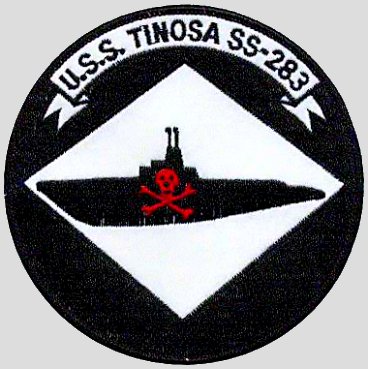
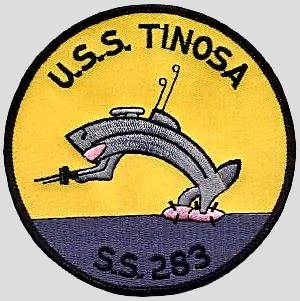
Patches contributed by Mike Smolinski
Tinosa (SS-283)
Unit Awards, Campaign and Service Medals and Ribbons
Presidential Unit Citation
Please report any broken links or trouble you might come across to the Webmaster.
Please take a moment to let us know so that we can correct any problems and make your visit as enjoyable and as informative as possible.


| Click On Image For Full Size | Size | Image Description | Source | |
|---|---|---|---|---|
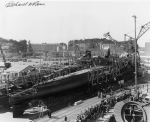 |
489k | The Wahoo (SS-238) is ready for launching at Mare Island Navy Yard on 14 February 1942. The Whale (SS-239) is on the building ways on the left and a hull section for Tinosa (SS-283) is just visible on the lower left corner of the photo. Her keel would be laid on the same ways on 21 February 1942. The large building in the rear of the photo is the Naval Hospital. Note: RADM Richard O'Kane has autographed the photo in the upper left corner. | USN photo # 764-42, courtesy of Darryl L. Baker. | |
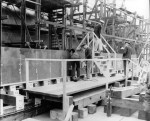 |
435k | Workmen are preparing the keel of the Tinosa (SS-283) for official laying on 21 February 1942 at Mare Island. | USN photo # 918-42, courtesy of Darryl L. Baker. | |
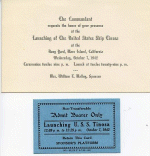 |
36k | An invitation and ticket for the launching of the Tinosa (SS-283) at Mare Island Navy Yard on 7 October 1942. | USN photo courtesy of Darryl L. Baker. | |
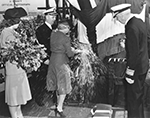 |
664k | Mrs. William E. Molloy christens the Tinosa (SS-283) at Vallejo, Calif., at the Mare Island Navy Yard on 7 October 1942. Over the next three years, she completed twelve war patrols in the Pacific and was credited with sinking 16 enemy ships, totaling 64,655 tons.
|
Text courtesy of DANFS. USN photo courtesy of subvetsofwwii.org. |
|
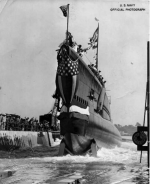 |
80k | Flags and bunting waving in the wake of her own breeze as she slides down south ways 3, the Tinosa (SS-283) is launched at Mare Island Navy Yard on 7 October 1942. Note the seawall on the right, the staffing shows between ways 3 & 4. | USN photo courtesy of tinosa283.com. & Darryl L. Baker. | |
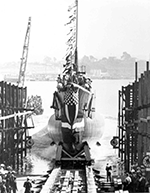 |
480k | Tinosa (SS-283) at the end of the ways at Mare Island Navy Yard on 7 October 1942. | USN photo courtesy of Scott Koen & ussnewyork.com. | |
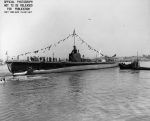 |
114k | The Tinosa (SS-283) shortly after her launching at Mare Island Navy Yard on 7 October 1942. The tug YMT-13 (ex-YT117) stands by the Tinosa to assist. Note barrage balloons in the background. | USN photo # 6162-42, courtesy of Darryl L. Baker. | |
 0828338 | 1.67k | After the Tinosa (SS-283) was launched, so were at least two future members of her crew at Great Lakes Naval Training Center graduating class, Illinois, November 1942. EM3c Polis & Charles H. Wagner Jr., TM3c | Official US Navy photo, courtesy of Mrs. Elizabeth A. Wagner. | |
 |
325k | Broadside view of the Tinosa (SS-283) off Mare Island on 5 March 1943. | USN photo # 1677-43, courtesy of Darryl L. Baker. | |
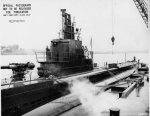 |
119k | The Tinosa (SS-283) is undergoing an inclining experiment at Mare Island after her refit on 27 March 1943. | USN photo # 2097-43, courtesy of Darryl L. Baker. | |
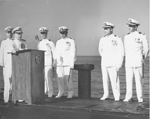 0855040 | 1.13k | Rear Admiral Lawrence Randall Daspit (Dan) of COMSUBLANT, COMNAVSUBFOR speaks before assembled officers. LCDR Bailey of the Barracuda (SST-3) is behind him. Dan Daspit was Tinosa's (SS-283) first CO. His account of the attack on Tonan Maru No. 3 is a jaw dropper. Although it is much juicer in Clay Blair's Silent Victory (pgs 435-439). Personally, my blood boils and consequently not even seeing those s.o.b.'s who contributed to the prolongation of the war, and the destruction of people's careers should be drawn, quartered, etc., is good enough, hopefully they will find a nice hot place in the earth. FYI None of this is in DANFS Despite the link above, I have included this on the assumption that things can change. After refitting at Midway, she got underway on 7 July to patrol the sea routes between Borneo and Truk. On 24 July 1943, Tinosa encountered the cargo ship Tonan Maru No. 3, the largest tanker of the Japanese fleet, 19,262 tons, sailing from Palau to Truk. Codebreaker warning [further explanation needed] had put Tinosa in a perfect position to shoot the tanker with a spread of four torpedoes. None exploded. The boat's commanding officer, Lieutenant Commander L. R. (Dan) Daspit recorded in his log, "Target had been carefully tracked and with spread used [torpedoes] could not have run properly and missed." The relevance of particular information in (or previously in) this article or section is disputed. The information may have been removed or included by an editor as a result. Please see discussion on the talk page considering whether its inclusion is warranted. (August 2019)
Tinosa made herself a second chance by chasing throughout the following day. Daspit also checked the torpedoes he had left and insured that the magnetic influence exploders had been disabled (see below for why). Even so, the first two torpedoes of the second attack had to be shot at an awkward angle and range. They hit and exploded disabling Tonan Maru's engines. With the target dead in the water Tinosa was in an ideal firing position, moving in to fire on the tanker at the submarine equivalent of point blank range. The torpedo appeared to hit its target but did not explode. Daspit and crew continued to fire torpedoes one at a time at the tanker. All of them hit, but none exploded. Daspit's log gives time of firing of each and states over and over again "fired [nth] torpedo. Hit. No apparent effect." Daspit recorded about the sixth one since Tonan Maru had become a "sitting duck", "... Hit. No apparent effect. This torpedo hit well aft on the port side, made splash at the side of the ship and was then observed to have taken a right turn and to jump clear of the water about 100 feet (30 m) from the stern of the tanker. I find it hard to convince myself that I saw this." |
Photo courtesy of Daniel L. Bailey Jr. | |
 0828321 | 421k | Tonan Maru No.3, a 19,000 plus ton 15 torpedo sitting duck. | Photo courtesy of combinedfleet.com | |
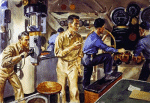 |
62k | A watercolor by the artist Dwight Clark Shepler entitled "Diving By Day" depicts the control room of a submarine. This can be reminiscent of the morning of 22 November 1943 during her 4th patrol, when Tinosa (SS-283) made a wild climb to 250 feet then dove to 380 feet, before her crew regained control. | Text courtesy of DANFS. Diving By Day Dwight Clark Shepler. #81, Watercolor, 1943. Courtesy of the USNHC, painting # 88-199-CE. |
|
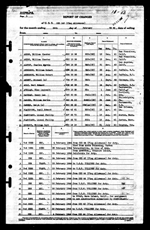 0828340 | 7.40k | Not a happy boat is a understatment: 31 December 1943 final onboard muster roll file 00221. Mass request of 39 applicants for duty on the Tullibee (SS-284), including 20 transfers in the waning days of February 1944. Those unlucky enough would catch her just in time to meet their death on her next & last voyage on 26 March 1944. The survivor of Tullibee Clifford Kuykendall, served with my dad on Tinosa (SS-283), he came aboard a month before him. He transferred off the Tinosa and onto the Tullibee in February 1944. | Photo & youtube link courtesy of the family of Charles H. Wagner Jr., TM2c (SS) USNR. Service from 1942-1946, aged 18-22, aboard S-37 (SS-142) & Tinosa (patrols 3-12). | |
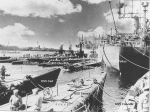 |
101k | Busy pier scene at Fremantle Australia 19 December 1943.
From left to right, stern view to the camera are the Bonefish (SS-223), Rasher (SS-269), Bowfin (SS-287), Bluefish (SS-222), Narwhal (SS-167) and the sub tender Pelias (AS-14). Second row, bow view are the Cod (SS-224), Tinosa (SS-283) and Crevalle (SS-291). I believe the only time that photo could have been taken was 19 December 1943. The Tinosa was in Fremantle only once, from 16 December 1943 to 10 January 1944. During that brief window, the Bonefish had not arrived until 19 December and the Rasher departed 19 December so that is the single date all three submarines were ever in Fremantle port at the same time. | Photo i.d. courtesy of Dan Goodell. USN photo courtesy of Ric Hedman. |
|
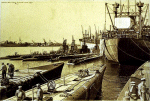 |
74k | A 1944 Charcoal drawing by the artist Griffith Baily Coale entitled "Busy Fremantle--Busy Mother" is reminiscent of the above photo by Lt. Herb Hanson. | Painting # 40 / 88-188-AN. Courtesy of the USNHC. |
|
 |
123k | The Japanese 5,401-ton ore carrier Seinan Maru is sunk by the Tinosa (SS-283) on 22 January 1944 in Balabac Strait, 07-19N, 116-52E. 29 crewmen and 16 gunners are KIA. | Photo & text courtesy of combinedfleet.com. | |
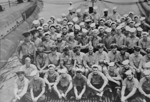 0828324 | 1.59k | Tinosa (SS-283) crew photo, 1944. Donald Frederick Weiss, now her 2nd CO, from the 5th war patrol (10 Jan. 1944) to her 7th war patrol, (July 1944). I'm almost certain Cdr. Weiss is seated, 2nd row, center. | Photo courtesy of the family of Charles H. Wagner Jr., TM2c (SS) USNR. Service from 1942-1946, aged 18-22, aboard S-37 (SS-142) & Tinosa (patrols 3-12). | |
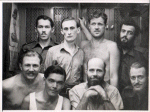 0828341 | 9.25k | Tinosa (SS-283) goes Borneo. 5 photo PDF insertion of Australian coast watchers on 5th patrol. Toward the end of the patrol reports are the separate filings for special missions, which include a covert operation during patrol 5 where the Tinosa dropped a team of Aussies on the NE coast of Borneo. The FM sonar special mission reports are also there. Turns out the Aussies were more than coastwatchers; they were troublemakers as well, and the second team (Python 1 preceded them) put in during the early stages of building resistance to the Japs on Borneo. Those report pages are attached; it revealed the name of the Aussie team: Python Two The same covert operation is described in the book Encounter, with additional information, pages 47-50, also attached. The Python 2 operation was part of an effort by the joint allied Z Special Unit, a covert group mostly Aussies, part of a larger effort summarized here: awm.gov.au There is a public domain photo featuring several of the team dropped by Tinosa, probably taken on the Harder after they were evacuated in June 1944; also attached (I added their names). Bill Jinkins and Gort Chester are both mentioned by name in the report and/or in Encounter. The official full caption for their photo is: Informal group portrait of Operation Python survivors aboard Harder. Identified, left to right, back row: Lindsay Cottee; Frederick Gordon (Fred) Olson; Stan Dodds; Stan Neil. Front row: Bill Jinkins; Alexander (Alec) Chew; Lieutenant Colonel Francis George Leach 'Gort' Chester DSO, OBE; Lloyd Woods. Operation Python was carried out by members of the Special Operations Executive the Allied commando unit Z Special Unit, during World War II. The objective of the mission was to set up a wireless station near Labuan Point, North Borneo, and undertake covert operations reporting on the sea lane of the Imperial Japanese Navy in the Sibutu Passage and the Balabac Strait of the Sulu Sea. The operation was split into Python I and Python II. Operation Python I was led by Major F Gort L Chester, the Z Special Unit operatives landed along Labuan Point in early October 1943. They also supported and provided equipment and stores for Filipino guerrillas under the command of an American officer, Captain J A Hamner. In January 1944, Bill Jinkins led Z Special Unit operatives on Operation Python II, with the objective of organising the local population for guerrilla warfare. It is from this web page: awm.gov.au Chester is written up here: awm.gov.au And here’s a link to a really great and detailed interview with Leonard Cottee, a team member and also in the picture, describing their activities in detail, including the drop of the Python 2 team and the bad outcomes to follow: australiansatwarfilmarchive, Unfortunately, 2 of the 6 men dropped by Tinosa were captured and executed by the Japs. | Photo & text courtesy of the family of Charles H. Wagner Jr., TM2c (SS) USNR. Service from 1942-1946, aged 18-22, aboard S-37 (SS-142) & Tinosa (patrols 3-12). | |
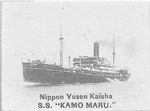 |
146k | After refitting, Tinosa (SS-283) departed the Marshalls on 7 June 1944, bound for the East China Sea. On 18 June, she resorted to unusual tactics in attacking a three-masted 400-ton fishing sampan which had withstood her gunfire. Tinosa closed the enemy vessel, doused her with fuel oil, and set her ablaze by tossing flaming, oil-soaked rags on her deck. Shortly after dawn on 2 July, Japanese planes and patrol vessels forced Tinosa to go deep near Nagasaki and kept her down until dusk. The following day, the submarine sank two passenger-cargo ships in an attack on a convoy, adding Konsan Maru and Kamo Maru to her list of kills. Following this patrol, Tinosa reported to Hunters Point, Calif., on 7 August, for a much needed overhaul. | Text courtesy of DANFS. Photo courtesy of wrecksite.eu via Tommy Trampp. | |
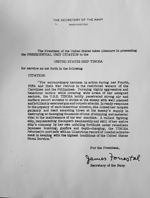 0828333 | 1.35k | Presidential Unit Citation for patrols 4, 5 & 6. | Photo courtesy of the family of Charles H. Wagner Jr., TM2c (SS) USNR. Service from 1942-1946, aged 18-22, aboard S-37 (SS-142) & Tinosa (patrols 3-12). | |
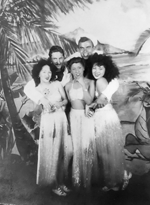 0828326 | 1.89k | R&R 1944 at Honolulu, TM3 C. Wagner, EM3c Polis, & some of the exotic scenery. | Photo courtesy of the family of Charles H. Wagner Jr., TM2c (SS) USNR. Service from 1942-1946, aged 18-22, aboard S-37 (SS-142) & Tinosa (patrols 3-12). | |
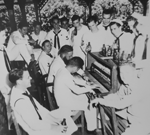 0828327 | 1.35k | R&R 1944 at Pearl Harbor, Honolulu. Bearded, at Piano, TM3c Robert “Benny” Bentham. | Photo courtesy of the family of Charles H. Wagner Jr., TM2c (SS) USNR. Service from 1942-1946, aged 18-22, aboard S-37 (SS-142) & Tinosa (patrols 3-12). | |
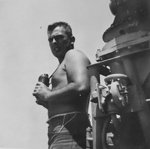 0828336 | 1.46k | TMc3 Wagner on the After Conning Tower Lookout Station, 1944. | Official US Navy photo, courtesy of Mrs. Elizabeth A. Wagner. | |
 0828335 | 1.97k | Tinosa (SS-283) Crew R&R 1944, Pearl Harbor. | Official US Navy photo, courtesy of Mrs. Elizabeth A. Wagner. | |
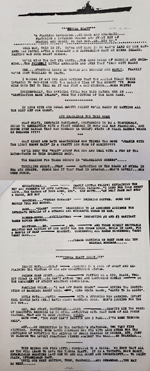 0828344 | 4.22k | 4 pages of memorable events in the life of the Tinosa (SS-283) & crew during the war, 1944. | Photos courtesy of Charles H Wagner Jr. & Mrs. Elizabeth A Wagner. | |
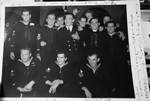 0828329 | 4.09k | These 2 photos are a PDF at a party for the torpedo crew and their officer, Ensign Keith Van Gorder at San Francisco, October 1944.
It was just after the FM sonar gear was installed and just prior to departing Pearl Harbor to put it into action.
Van Gorder was the Torpedo Officer and was leaving the ship; dad had been under him on 2 patrols.
On one patrol a torpedo got stuck exiting a bow tube and became armed because they were escaping escorts and had to move.
After they escaped the escorts they surfaced and Van Gorderand an enlisted man went overboard to wedge the impeller so the fish wouldn’t go off when it wound down.
He got a Silver Star for that one.
They pulled an all ahead/all astern maneuver and it came loose and dropped to the bottom.
Many brows wiped that day.
But later they used the FM sonar to map the minefields around Okinawa and Iwo Jima. MORE brows wiped. For those who have or have not read Clay Blair's Silent Victory, pgs. 789/90 that deal with the testing of the FM sonar, you can find it here. Not so well known, is that after the first patrol with Latham several more men shipped off, because they felt he was not aggressive enough – what they didn’t get (because no one knew exactly where they were) was that he avoided attacking any sightings because mapping the Okinawa and Iwo Jima (less well publicized) minefields, and getting the maps back safely was his highest priority. Tinosa also had a circular run. Dad had been working on the fish with Benny Bentham; the rudder was sticky even though they lubed and worked it. They recommended taking it out of service, but because of special missions the after fish house only had four fish and they were told to load it anyway. Oops, almost. The sonar guy heard it coming around and they dove fast enough to get under it, but the whole boat could hear it go over them. The TM’s were on the shit list for a week or two after that one, but the TM’s were insistent that the guys on Proteus (AS-19) should have caught that one. The TM’s didn’t open the fish up, they just maintained them, so sticky or chipped internal steering linkage was not in their purview. Because they all had at least one patrol under Daspit, they were exceptionally attentive to torpedo issues; far more so than persons new to the boat. | Photo courtesy of the family of Charles H. Wagner Jr., TM2c (SS) USNR. Service from 1942-1946, aged 18-22, aboard S-37 (SS-142) & Tinosa (patrols 3-12). | |
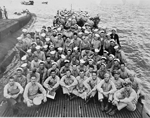 0828334 | 2.98k | Tinosa (SS-283) crew photo, April 1945. Upper Blk Dot TMc2 Wagner, Lower Blk Dot, TM3c Polis. Boat in the back is from the Proteus (AS-19). | Official US Navy photo, courtesy of Mrs. Elizabeth A. Wagner. | |
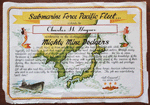 0828330 | 2.54k | Let all men who read this scroll be forever grateful and respectful of those heroic American submariners who went in and especially to those who gave their lives in this operation. The job was superlatively well done. Chas Lockwood Vice Admiral This was Operation Barney | Operation Barney link courtesy of Steven Trent Smith, World War II Magazine via navytimes.com Photo courtesy of the family of Charles H. Wagner Jr., TM2c (SS) USNR. Service from 1942-1946, aged 18-22, aboard S-37 (SS-142) & Tinosa (patrols 3-12). | |
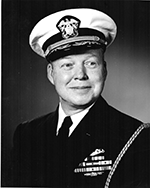 | 232k | Photo of CDR James L. Hunnicutt, USNR awarded the Navy Cross as Commanding Officer of Carp (SS-338) for her first war patrol for the period of 8 June 1945 to 2 August 1945. He was awarded the Silver Star of his action as Assistant Approach Officer aboard Tinosa (SS-283) between 29 March to 15 May 1944. | Photo from the files of the Vallejo Naval & Historical Museum via Darryl L. Baker. | |
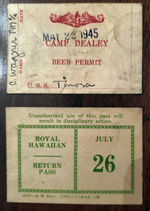 0828328 | 1.59k | Three photo PDF: Cut off at the pass, 1944/45. | Photo courtesy of the family of Charles H. Wagner Jr., TM2c (SS) USNR. Service from 1942-1946, aged 18-22, aboard S-37 (SS-142) & Tinosa (patrols 3-12). | |
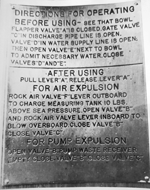 0828331 | 658k | Yes Can Do: Instruction Plate. | Photo courtesy of the family of Charles H. Wagner Jr., TM2c (SS) USNR. Service from 1942-1946, aged 18-22, aboard S-37 (SS-142) & Tinosa (patrols 3-12). | |
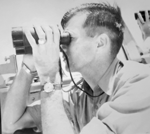 0828322 | 354k | Richard Clark Latham, USN, last wartime CO of the Tinosa (SS-283), served from 13 September 1944 to 16 August 1945. | Text info courtesy of uboat.net Photo courtesy of the family of Charles H. Wagner Jr., TM2c (SS) USNR. Service from 1942-1946, aged 18-22, aboard S-37 (SS-142) & Tinosa (patrols 3-12). | |
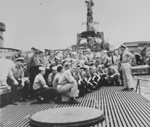 0828323 | 1.91k | Tinosa (SS-283) crew photo, 1945. Cdr Latham is standing, right. | Photo courtesy of the family of Charles H. Wagner Jr., TM2c (SS) USNR. Service from 1942-1946, aged 18-22, aboard S-37 (SS-142) & Tinosa (patrols 3-12). | |
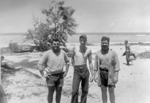 0828325 | 1.73k | R&R May, 1945 at Camp Dealey, TM2 C. Wagner, EM3c Polis, & TM3c Bentham. | Photo courtesy of the family of Charles H. Wagner Jr., TM2c (SS) USNR. Service from 1942-1946, aged 18-22, aboard S-37 (SS-142) & Tinosa (patrols 3-12). | |
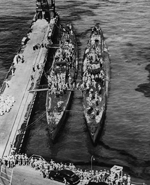 |
390k | Hellcats get together one by one: From inboard to outboard: Flying Fish (SS-229) & Spadefish (SS-411), July 1945. |
USN photo courtesy of Scott Koen & ussnewyork.com. | |
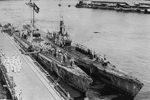 |
269k | Hellcats get together two plus one: From inboard to outboard: Flying Fish (SS-229), Spadefish (SS-411) & with Bowfin (SS-287) approaching, July 1945. |
USN photo courtesy of Scott Koen & ussnewyork.com. | |
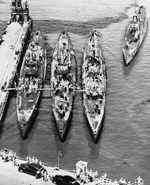 |
298k | Hellcats get together three plus one: From inboard to outboard: Flying Fish (SS-229), Spadefish (SS-411), Bowfin (SS-287) with Tinosa (SS-283) approaching, July 1945. |
USN photo courtesy of Scott Koen & ussnewyork.com. | |
 |
241k | Hellcats get together with one to go: From inboard to outboard: Flying Fish (SS-229), Spadefish (SS-411), Bowfin (SS-287), Tinosa (SS-283) & Skate (SS-305) approaching, July 1945. |
USN photo courtesy of Scott Koen & ussnewyork.com. | |
 |
192k | All together now: From inboard to outboard: Flying Fish (SS-229), Spadefish (SS-411), Bowfin (SS-287), Tinosa (SS-283) & Skate (SS-305) July 1945. |
USN photo courtesy of Scott Koen & ussnewyork.com. | |
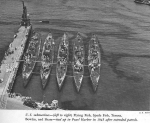 |
58k | Flying Fish (SS-229), Spadefish (SS-411), Tinosa (SS-283), Bowfin (SS-287), and Skate (SS-305) as they appeared from a photo taken at the top of training tower at Sail 9 in 1945. | USN photo courtesy of Grant Riddle & submarinebaseph.com from centerfold of Bowfin museum brochure. | |
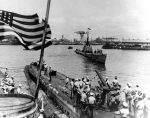 |
57k | Photo taken from the pier above the Spadefish (SS-411) as the Tinosa (SS-283), all decked out with flags flying from her mast, returns after her 11th patrol, arriving at Pearl Harbor on 4 July 1945. | Text courtesy of DANFS. USN photo courtesy of ussubvetsofwwii.org. & David Johnston | |
 |
290k | Photo taken from the pier above the Spadefish (SS-411) as the Tinosa (SS-283), all decked out with flags flying from her mast, returns after her 11th patrol, arriving at Pearl Harbor on 4 July 1945. This shot appears to have been taken moments after the first. | Text courtesy of DANFS. USN photo courtesy of Robert Hurst. | |
 |
269k | Crew get together; From inboard to outboard: Flying Fish (SS-229), Spadefish (SS-411), Tinosa (SS-283) and Skate (SS-305), July 1945. |
USN photo courtesy of Scott Koen & ussnewyork.com. | |
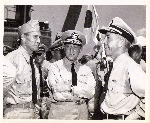 |
218k | As was his tradition, Vice Admiral Charles A. Lockwood, Jr., USN (Commander Submarine Force Pacific) (center) greets the Commanding Officer of Tinosa (SS-283) Commander R. C. Latham, USN (left) upon his homecoming from the 11th War Patrol to the Japanese home waters on 4 July 1945. Comdr. Latham gives Admiral Lockwood the tally: four Japanese vessels sunk and a fifth severely damaged, as Commodore Merrill Comstock, USN (Chief of Staff) (right) looks on. |
Official USN photo File #336207 from The Office of Public Information, Navy Department, Washington, D.C., courtesy of Robert M. Cieri. | |
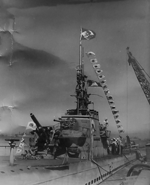 0828337 | 294k | Tinosa (SS-283) at Pearl Harbor, crane loading torpedo, July 1945. | Official US Navy photo, courtesy of Mrs. Elizabeth A. Wagner. | |
 0828339 | 1.48k | R&R July, 1945. The beer obviously tastes better than the sound of exploding depth charges. | Official US Navy photo, courtesy of Mrs. Elizabeth A. Wagner. | |
 |
79k | Tinosa (SS-283), broadside view, circa 1943-45, location unknown. | USN photo courtesy of John Hummel, USN (Retired). | |
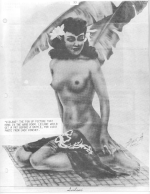 |
72k | The (Good Luck) Pinup girl that hung in the Tinosa's (SS-283) Wardroom. She would receive a pat just prior to going to "Battle Stations." | USN drawing by Jack Hinchey. Text courtesy of tinosa283.com. |
|
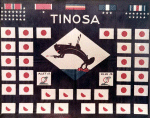 |
63k | WW II Battleflag of the Tinosa (SS-283). | USN photo courtesy of ussubvetsofwwii.org. | |
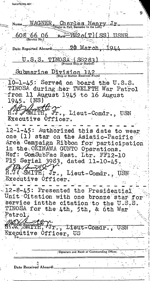 0828345a | 91k | The unannounced commendation for Tinosa's (SS-283) minefield mapping activities around Okinawa prior to the landings. A crew award, in a restricted letter from ComSubPac: | Photo courtesy of the family of Charles H. Wagner Jr., TM2c (SS) USNR. Service from 1942-1946, aged 18-22, aboard S-37 (SS-142) & Tinosa (patrols 3-12). | |
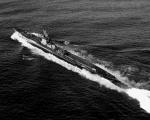 |
126k | Portside view of the Tinosa (SS-283), circa 1945. | USN photo. | |
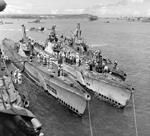 | 776k | Guam on 9 April 1945. From left to right: Probably the Spadefish (SS-411), Tinosa (SS-283) & Balao (SS-285). Note that the boat on the left has been censored. As such Robert Morgan wrote: I'm now wondering about the date of the photo. Its not taken at the same part of the sub base where Hydeman's pack tied up so the boats (if it is them) have clearly been shuffled around. The boat to Tinosa's right with the censoring is not Flying Fish (SS-229) - her limber pattern is all wrong. Assuming the pinching in of the casing abaft of the bridge is really there and not a censoring artifact, then she's either a late war Balao or Tench based upon that and the pattern. I'll try to narrow the hull number range. Its a shame the censor obliterated so much. Speaking of which, its odd how the censor did so much damage to that one boat and then not on the others, almost as if the war had just ended and he realized, "Hey, I can stop doing this now!" The SV radars might be censored, but that's it. If so, that would also argue against the other boats being returnees from the Sea of Japan. Tinosa departed on one last patrol before the end, so that may explain the movement as she and the other Sea of Japan boats were moved around and prepped for further patrols or refits. | Text i.d. courtesy of David Johnston (USNR) & Robert Morgan. | |
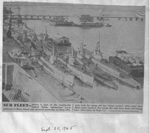 |
1.18k | The table below lists the location of submarines at Mare Island on 20 September 1945. This information was pulled from microfiche copies of the hand written shipyard journals. I’m surprised that both the clipping and my table show 21 subs at the yard on the date in question. The photo is looking north and berth 3 is at the top of the photo and then the berths run down or south. Berth 3 - Springer (SS-414) & Spadefish (SS-411) Berth 4 - Guavina (SS-362) & Barbero (SS-317) Berth 5 - Hammerhead (SS-364), Tinosa (SS-283), Mapiro (SS-376) & Moray (SS-300) Berth 6 - Bream (SS-243), Seahorse (SS-304), Batfish (SS-310) & Aspro (SS-309) Berth 7 - Pomfret (SS-391), Parche (SS-384) & Sunfish (SS-281) Berth 8 - Queenfish (SS-393) Berth 9 - Lionfish (SS-298) & Plaice (SS-390) Dry Dock 1 - Bashaw (SS-241) & Mingo (SS-261) Berth 12 - Guitarro (SS-363). |
Photo i.d. & text courtesy of Darryl L. Baker. Photo courtesy of Ron Reeves (of blessed memory). | |
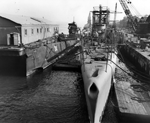 | 1.0m | Parche (SS-384) with YF-312 and S-30 (SS-135) outboard at Mare Island between 19 and 23 October 1945. The submarine to the left of Parche's sail is either Plaice (SS-390), Tinosa (SS-283) or Queenfish (SS-393). The Nereus (AS-17) is just visible left of the Parche's periscope shears. | USN photo courtesy of Darryl L. Baker. | |
 0828332 | 2.66k | Tinosa (SS-283) crew photo, 8 December 1945, probably San Diego. | Official US Navy photo, courtesy of Mrs. Elizabeth A. Wagner. | |
 0828383p | 104k | Tinosa (SS-283) lapel pin; three service stars for three successful patrols as mentioned in her PUC on page 8 DANFS The “tests” mentioned in DANFS “Tinosa departed San Diego on 7 November 1944 and proceeded, via Pearl Harbor, to Nansei Shoto to recon-noiter its waters and to test new FM sonar equipment in locating Japanese mines. After 58 days at sea, Tinosa returned to Pearl Harbor.” were actually harbor reconnaissance and mine mapping missions in preparation for the 1 April 1945 landings on Okinawa. They were written up in special secret reports filed independently from the standard after-action patrol reports. | Official US Navy photo, courtesy of Charles H. Wagner Jr. & Mrs. Elizabeth A. Wagner. | |
 | 137k | Reserve fleet at Mare Island, circa January 1946. There are 52 submarines and 4 Sub Tenders in this photo. This photo is a Berthing list identifying the ships in the picture. | Photo commemorating 50 years, U. S. Submarine Veterans of WW II 1996 calendar, courtesy of Darryl L. Baker. | |
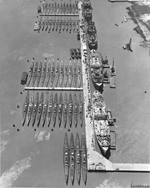 | 453k | Photo of the Reserve fleet at Mare Island, circa January 1946. There are 52 submarines and 4 Sub Tenders in this photo. Whether coincidental or on purpose, the number of boats in the photo is the same as that which were lost in WW II. From back to front and left to right, first group of 12 boats: Sand Lance (SS-381) Tunny (SS-282) Aspro (SS-309) Lionfish (SS-298) Guvania (SS-362) Sunfish (SS-281) Macabi (SS-375) Gurnard (SS-254) Pampanito (SS-383) Mingo (SS-261) Guitarro (SS-363) Bashaw (SS-241) From back to front and left to right, second group of 12 boats: Sealion (SS-315) Hammerhead (SS-364) Bream (SS-243) Seahorse (SS-304) Tinosa (SS-283) Pintado (SS-387) Mapiro (SS-376) Pipefish (SS-388) Moray (SS-300) Batfish (SS-310) Hackleback (SS-295) Bluegill (SS-242) From back to front and left to right, third group of 12 boats: Hawkbill (SS-366) Menhaden (SS-377) Perch (SS-313) Loggerhead (SS-374) Barbero (SS-317) Baya (SS-318) Hardhead (SS-365) Spadefish (SS-411) Springer (SS-414) Devilfish (SS-292) Kraken (SS-370) Dragonet (SS-293) From back to front and left to right, fourth group of 12 boats: Lamprey (SS-372) Piranha (SS-389) Manta (SS-299) Pargo (SS-264) Rancador (SS-301) Archerfish (SS-311) Mero (SS-378) Sawfish (SS-276) Spot (SS-413) Lizardfish (SS-373) Jallao (SS-368) Icefish (SS-367) From back to front and left to right, last group of 4 boats: Steelhead (SS-280) Puffer (SS-268) Stickleback (SS-415) Trepang (SS-412) From back to front, Submarine Tenders group of 4 ships: Pelias (AS-14) Aegir (AS-23) Euryale (AS-22) Griffin (AS-13) | Photo commemorating 50 years, U. S. Submarine Veterans of WW II 1996 calendar, courtesy of Darryl L. Baker. | |
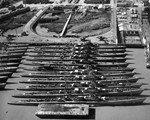 |
1.93k | Aerial view of decommissioned submarine at Mare Island Reserve Fleet taken on 18 March 1946. The majority of the personnel topside are navy personnel. I would say they are still inactivating the subs. Submarines are from top to bottom: Bashaw (SS-241), Guitarro (SS-363), Mingo (SS-261), Gurnard (SS-254), Pampanito (SS-383), Sand Lance (SS-381), Bream (SS-243), Hammerhead (SS-364) Sealion (SS-315), Tinosa (SS-283) & Pintado (SS-387) plus YC 316. |
USN photo courtesy of the Vallejo Naval & Historical Museum via Darryl L. Baker. | |
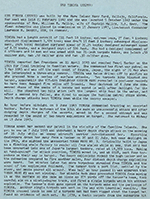 |
1.01k | 8 photo PDF history of the Tinosa (SS-283). | USN photo courtesy of Scott Koen & ussnewyork.com. | |
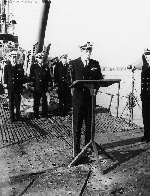 |
112k | LCDR L. H. Butt reads his orders as he assume command of Tinosa (SS-283) at Mare Island on 4 January 1952. | USN photo # 11434-1-52, courtesy of Darryl L. Baker. | |
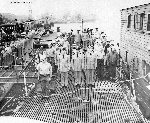 | 245k | Photo of the decommissioning ceremonies of Scabbardfish (SS-397) at Mare Island on 27 November 1953. Tinosa (SS-283) is inboard of Scabbardfish. | USN photo # 19449-11-53, courtesy of Darryl L. Baker. | |
 |
201k | Portside view of the Tinosa (SS-283), probably laid up in the Pacific Reserve Fleet, Mare Island Group, after she was decommissioned, 2 December 1953. | USN photo courtesy of ussubvetsofwwii.org. | |
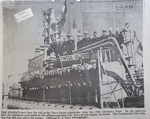 0828343 | 12.4k | 11 pages of memorable events in the life of the Tinosa (SS-283) & crew, war & post war, Captain's report, reunions, etc. | Photos courtesy of the family of Charles H. Wagner Jr., TM2c (SS) USNR. Service from 1942-1946, aged 18-22, aboard S-37 (SS-142) & Tinosa (patrols 3-12). | |
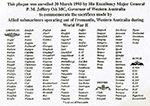 |
365k | This plaque was unveiled 20 March 1995 by His Excellency Major General P.M. Jeffery OA MC, Governor of Western Australia to commemorate the sacrifices made by Allied submarines that operated out of Fremantle, Western Australia during WW II. | Photo courtesy of Ron Reeves (of blessed memory). | |
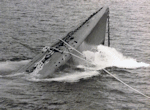 |
223k | Tinosa (SS-283) at the end of her above ocean career. | Photo courtesy of John Hummel, USN (Retired). | |
| Back To The Main Photo Index | Back To the Submarine Index |
|
Problems and site related matters, E-mail Webmaster |
|
This page was created and maintained by Michael Mohl All Pages © 1996 - 2025 NavSource History All rights reserved. |